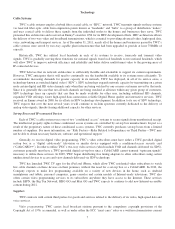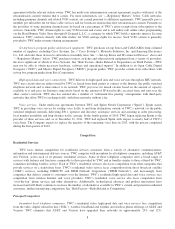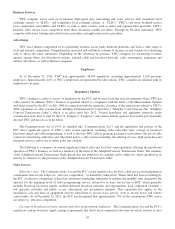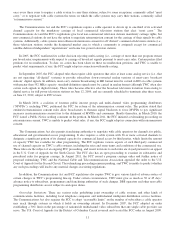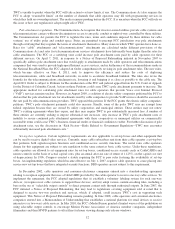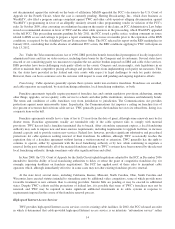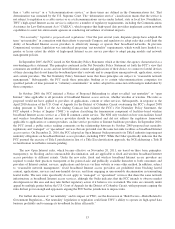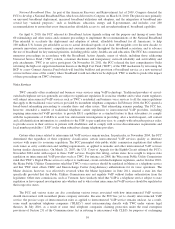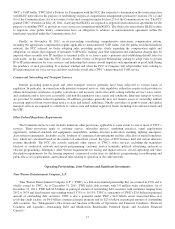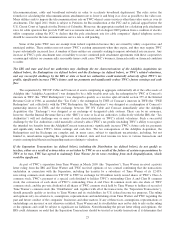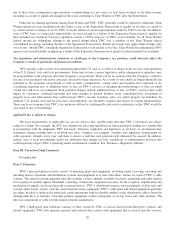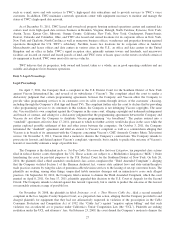Time Warner Cable 2011 Annual Report Download - page 25
Download and view the complete annual report
Please find page 25 of the 2011 Time Warner Cable annual report below. You can navigate through the pages in the report by either clicking on the pages listed below, or by using the keyword search tool below to find specific information within the annual report.TWC’s VoIP traffic, TWC filed a Petition for Preemption with the FCC that requested a determination that interconnection
with RLEC networks for the purpose of establishing reciprocal compensation arrangements pursuant to sections 251 (a) and
(b) of the Communications Act is not subject to the rural exemption under Section 251 of the Communications Act. The FCC
granted TWC’s Petition on May 26, 2011, clarifying that RLECs are required to negotiate interconnection agreements for the
purpose of enabling TWC to provide its voice service in competition with RLECs. The Order also states that if RLECs refuse
to negotiate, state public utility commissions have an obligation to arbitrate an interconnection agreement within the
timeframes specified under the Communications Act.
Finally, on November 18, 2011, in its proceeding considering comprehensive intercarrier compensation reform,
including the appropriate compensation regime applicable to interconnected VoIP traffic over the public switched telephone
network, the FCC released an Order adopting rules providing greater clarity regarding the compensation rights and
obligations of carriers that originate or terminate VoIP traffic, making clear that origination and termination charges may be
imposed when an entity uses IP facilities to transmit traffic to or from a party’s premises and establishing default rates for
such traffic. At the same time the FCC issued a Further Notice of Proposed Rulemaking seeking to adopt rules to govern
IP-to-IP interconnection for voice services and indicating that carriers should negotiate such agreements in good faith during
the pendency of such proceeding. It is unclear whether and when the FCC or Congress will adopt further rules relating to
IP interconnection for voice services and how such rules would affect TWC’s interconnected VoIP service.
Commercial Networking and Transport Services
Entities providing point-to-point and other transport services generally have been subjected to various kinds of
regulation. In particular, in connection with intrastate transport services, state regulatory authorities require such providers to
obtain and maintain certificates of public convenience and necessity and to file tariffs setting forth the service’s rates, terms,
and conditions and to have just, reasonable, and non-discriminatory rates, terms and conditions. Interstate transport services
are governed by similar federal regulations. In addition, providers generally may not transfer assets or ownership without
receiving approval from or providing notice to state and federal authorities. Finally, providers of point-to-point and similar
transport services are required to contribute to various state and federal regulatory funds, including state universal funds and
the USF.
Other Federal Regulatory Requirements
The Communications Act also includes numerous other provisions, applicable to some extent, to one or more of TWC’s
services. These provisions apply to customer service, subscriber privacy, marketing practices, equal employment
opportunity, technical standards and equipment compatibility, antenna structure notification, marking, lighting, emergency
alert system requirements, disability access, loudness of commercial advertisements and the collection of annual regulatory
fees, which are calculated based on the number of subscribers served, the types of FCC licenses held and certain interstate
revenue thresholds. The FCC also actively regulates other aspects of TWC’s video services, including the mandatory
blackout of syndicated, network and sports programming; customer service standards; political advertising; indecent or
obscene programming; Emergency Alert System requirements for analog and digital services; closed captioning and video
description requirements for the hearing impaired; commercial restrictions on children’s programming; recordkeeping and
public file access requirements; and technical rules relating to operation of the cable network.
Operating Partnerships, Joint Ventures and Significant Investments
Time Warner Entertainment Company, L.P.
Time Warner Entertainment Company, L.P. (“TWE”) is a Delaware limited partnership that was formed in 1992 and is
wholly owned by TWC. As of December 31, 2011, TWE held cable systems with 3.0 million video subscribers. As of
December 31, 2011, TWE had $2.6 billion in principal amount of outstanding debt securities with maturities ranging from
2012 to 2033 and fixed interest rates ranging from 8.375% to 10.15%. TWC is a guarantor of TWE’s $2.6 billion in principal
amount of outstanding debt securities. TWE is also a guarantor under TWC’s $4.0 billion senior unsecured three-year
revolving credit facility, its $4.0 billion commercial paper program and its $23.6 billion in principal amount of outstanding
debt securities. See “Management’s Discussion and Analysis of Results of Operations and Financial Condition—Financial
Condition and Liquidity—Outstanding Debt and Mandatorily Redeemable Preferred Equity and Available Financial
Capacity.”
17


